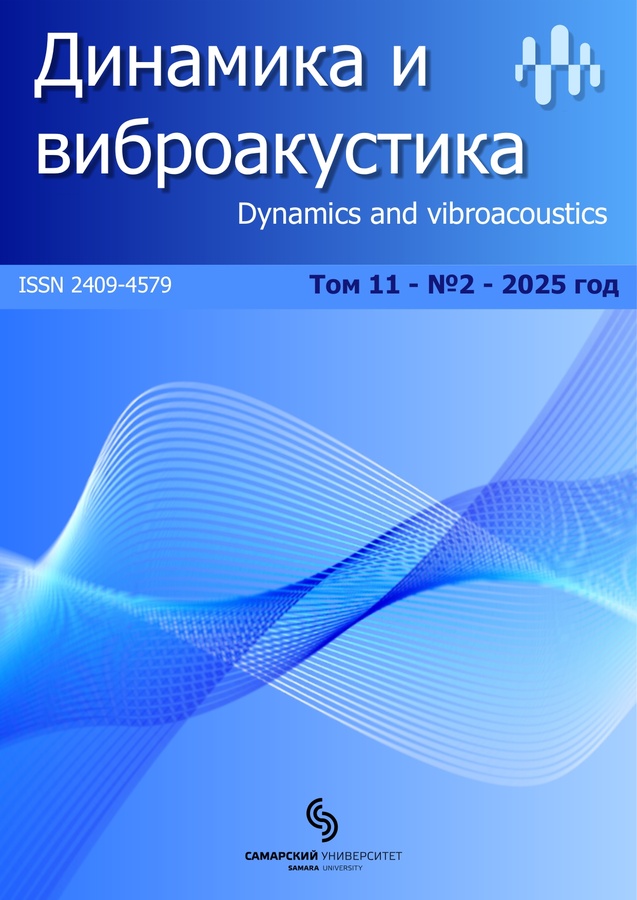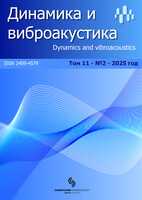Journal of Dynamics and Vibroacoustics
For publication in the "Dynamics and vibroacoustics" journal articles are accepted by field of the following science:
- 01.00.00 - physical and mathematical sciences;
- 02.00.00 – chemical sciences;
- 05.00.00 – engineering science.
to the following research topics:
1. Fundamental problems in dynamics and vibroacoustics machines.
2. Vibration and problems of the damping.
3. Modelling of dynamic and vibroacoustic processes.
4. Suppression of oscillatory processes and noise.
5. Dynamics and control systems.
6. Mechatronics, mechatronic systems.
7. Aero-and hydro-acoustics.
Ағымдағы шығарылым
Том 11, № 2 (2025): :27.06.2025
Articles
Development of a mathematical model for optimizing the milling process to increase the fatigue limit of products and minimize the stress of the cutting process
Аннотация
The presented article demonstrates the work on setting up full-scale and numerical experiments on the milling process of D16 and L63 alloys. The results of field experiments were dependences linking the roughness parameters with the parameters of the milling mode applied to alloys D16 and L63. These dependencies can be used to optimize technological processes when it is necessary to assign such processing modes that will ensure the surface roughness specified by the designer. In addition, these dependencies were used by the authors to modernize the formulas for determining the effective stress concentration coefficient, which has practical benefits at the stages of design and technological preparation of production. The result of the numerical experiment were dependences that allow us to determine the maximum equivalent stresses that occur along the cutting section of the cutters during processing of the alloys studied in this work. The integrated application of the results of this study can have a positive impact on production both in achieving maximum product quality and in ensuring the economic development of the enterprise by choosing processing modes that spare the processing tool.
 7-18
7-18


Methodology for assessing the vibration activity of an aggregated hydraulic device under test bench conditions
Аннотация
In this paper, we consider the issue of evaluating the vibration activity of complex multichannel aggregated hydraulic devices (AD) that combine in their design several simultaneously involved working elements (throttles, spool valves), flow channels of complex geometry, and control elements of various modes. In such conditions, it is extremely important to determine the contribution of the main elements to the resulting vibration characteristic of the device. To perform these works, it is necessary to develop an order and methodology for their implementation. The paper presents the main provisions of the developed methodology and the results of their implementation, including the following sequence of actions:
- Before installing the AD on the bench, the natural frequencies of free vibrations of the structure and its elements were determined by its free suspension. The results obtained were taken into account in the subsequent analysis.
- A program for measuring the vibration characteristics of the AD in various hydraulic modes of operation was developed. A map of vibration control points was compiled, determining the characteristics of specific structural elements of the AD design.
- A form of presentation and analysis of vibration characteristics at measurement points with a temperature distribution of the results over 1/3 octave frequency bands was developed.
- The planned tests were carried out, the results were analyzed, and the directions of work to improve the design of the AD and its test conditions were determined.
The results of applying the above methodology in testing the vibration activity of the experimental AD sample made it possible both to determine the direction of improvement of its design and to optimize the operating modes of the main working bodies.
 19-28
19-28


Speckle interferometer setup for continuous recording of GTE structure vibration states
Аннотация
The developed speckle interferometer setup is intended for automatic study of vibration modes and frequencies of gas turbine engine structures by scanning in a given frequency range. The correlation of each snapshot with a specific vibration frequency of the object is provided through harmonic signal scanning and video stream control using a single computer program. The program result is an interferometric film with information on the object vibration state at all frequencies in a given range. Resonance frequencies are determined by the statistical criterion of speckle interferograms. The developed setup was used to investigate compressor blade vibration modes and frequencies. The transition of compressor guide vane vibration from one mode to another with an increase in the exciting signal frequency was studied.
 29-37
29-37


Combination diagnostic features of technical condition of planetary gearboxes for gas-turbine engines
Аннотация
It is shown that, by analogy with combination diagnostic features, in diagnostics of technical condition of gas turbine engines it is possible to successfully use structural diagnostic features as sum or difference of uniform parameters; their use, when analyzing the signals from "standard" tachometric shaft speed sensors, considerably simplifies the procedure for accessing the technical condition of an object under study in comparison with the analysis of vibration processes. As is the case with combination diagnostic features, various characteristics of diagnostic features can be used: the width of spectral components at different levels, the frequency deviation parameters in narrowband processes, and others.
 38-45
38-45


Dynamic loading conditions of radial bearings of rocket steering units of liquid rocket engine steering units
Аннотация
A brief review of existing and newly developed methods for calculating the friction moment of radial bearings of rocking units is given using the most common domestic articulated steering units of liquid-propellant rocket engines as an example. An analysis of the kinematic diagram of the steering drive is carried out, the leading element of which is the shaft of the launch vehicle steering machine. Analytical dependencies of the time-varying force coming to the actuator of the steering unit are obtained, which were subsequently compared with a similar experimental characteristic recorded during a full-scale fire test. An analytical and graphical dependence of the load on the actuator as a time function at specified angular velocities of the steering unit shift is given, the procedure for converting this force into a radial load on the bearing is shown. The field of application of the obtained refined data in studying the torque characteristics of low-speed radial bearings of steering units is determined.
 46-55
46-55


Calculated detuning from flutter and experimental validation of the energy method of its prediction in the blades of the GTE compressor
Аннотация
The work is devoted to demonstrating the effectiveness of the energy method for predicting self-oscillations (flutter) using the example of a monowheel of the 1st stage of a low-pressure compressor of a gas turbine engine. Flutter was detected during engine tests by the monowheel strain gauge method and using contactless diagnostic tools. Using an engineering calculation technique based on the energy method, the monowheel was detuned from flutter by re-profiling the blades. The calculated distribution of the work of non-stationary aerodynamic forces on the elastic movements of the blade during the oscillation cycle according to its own shape allows the designer to focus on the contribution of certain areas of the blade during detuning from the flutter and minimize the loss of aerodynamic parameters. In this work, for the first time in the domestic engine industry, an experimental verification of the absence of a flutter of a computationally tuned compressor impeller was successfully carried out using the energy method when testing it as part of an engine. The developed technique makes it possible to obtain a significant economic effect from reducing the volume of tests and eliminating the risk of engine failure.
 56-72
56-72


Selection of the geometric shape of the flow path of a remotely controlled valve to minimize its acoustic radiated power of turbulent noise and hydraulic resistance
Аннотация
The article investigates the acoustic power radiation of an isotropic turbulent flow of superheated steam in the flow path of an angle shut-off valve through numerical simulation. The study aims to determine the geometric dimensions of the valve's flow path that minimize the acoustic radiation power into the connected pipeline mains for a given medium velocity in the inlet pipe. Certain parameters of the valve's flow path are subject to design constraints, dictated by the existing component base (bellows with limitations on maximum allowable pressure and compression) and requirements for minimal valve dimensions (particularly the actuator, whose size is determined by the seat diameter). As part of the study, the effectiveness of various measures to modify the base valve design was evaluated through detailed numerical hydrodynamic and acoustic modeling. These measures, aimed at reducing the acoustic power of the flow in the valve, were analyzed both individually and in combination. The authors found that the most effective measures were: changing the lift height of the valve plug and modifying the radial dimensions of the annular cavity between the plug and the bushing. The calculated effectiveness of these measures reaches up to 11 dB. The obtained results are recommended for use in the refinement of shut-off valves in pneumatic and hydraulic systems to reduce the noise they generate.
 73-86
73-86


Assessment of incidence angles of acoustic pressure waves on the surface of the stringer structure of the dry compartment during rocket launch
Аннотация
The paper presents experimental characteristics of sound insulation of the stringer compartment of the launch vehicle. It is shown that the resonant dips in the sound insulation spectrum, changing from launch to launch, depend on the angles of incidence of acoustic waves on the compartment surface. These conclusions were drawn on the basis of the mathematical model allowing to consider angular falling of acoustic waves on the cylindrical shell. Formulas for estimating the equivalent characteristics of the stringer shells of the compartments are proposed to evaluate the studied sound insulation parameters (equivalent thickness, elastic modulus, density, cylindrical and membrane rigidity).
 87-96
87-96


Method for determining the confidence limits of errors in measured parameters of an inhomogeneous flow at the inlet of an aircraft gas turbine engine compressor
Аннотация
To analyze the results of measuring the parameters of the inhomogeneous flow at the compressor inlet, a method has been developed for determining the confidence limits of the errors of these parameters. The proposed method makes it possible to determine the marginal errors of the total absolute pressure at various measuring points, as well as parameters characterizing pulsations and uneven flow at the compressor inlet. A distinctive feature of the developed method is the ability to account for both non-excluded systematic and random errors. Testing the method allowed us to recommend the number of atmospheric pressure measurements during the engine test in one mode. It was also possible to establish the possibility of reducing the error in determining the complex criterion for evaluating the heterogeneity of the flow, while increasing the accuracy class of the full pressure measuring instrument at various points in the cross-section at the compressor inlet.
 97-110
97-110











